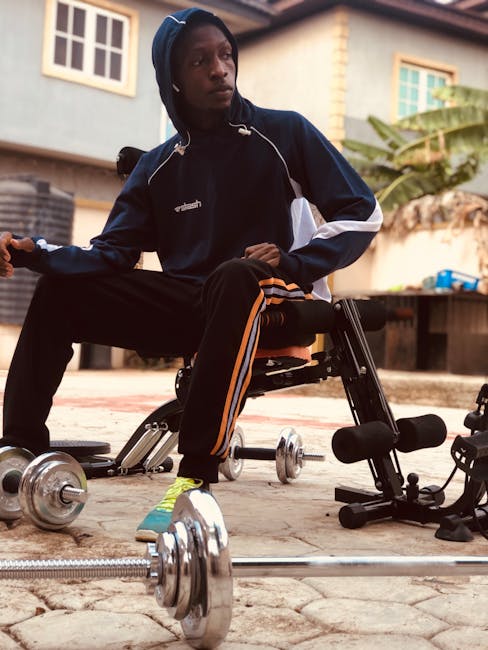Do you ever feel like a hernia is just cramping your lifting style? Well, fear not my swole-mates, because I’ve got a professional guide that will help you manage those pesky protrusions and get back to pumping iron like a champ. In this article, we’ll explore the ins and outs of hernias, how they interact with your workouts, and what steps you can take to keep them from ruining your gains. Grab some chalk and get ready to flex those brains, because we’re diving deep into the world of managing hernias through weightlifting. Let’s do this.
Contents
1. Introduction to Hernias and Weightlifting
Ah, the joys of weightlifting. Trying to lift as heavy as possible, grunting noises, and the feeling of accomplishment when you hit a new PR. You may think you’re invincible in the gym, but even the strongest of us have our weaknesses. One common weakness that can affect weightlifters is a hernia.
A hernia occurs when an organ or tissue pushes through a weak spot in a muscle or surrounding connective tissue. This can occur in the abdomen, groin area, or even near your naval. The most common type of hernia for weightlifters is an inguinal hernia, which occurs in the groin area. This happens when the intestines push through a weak spot in the abdominal wall. Sounds fun, right?
So, why are weightlifters at a higher risk for hernias? It’s simple. The increase in abdominal pressure during heavy lifting can exacerbate existing hernias or even cause new ones. This is particularly true for exercises like squats and deadlifts, which put a lot of strain on the core and pelvic muscles. But don’t worry, it’s not all doom and gloom. By taking some preventative measures, you can reduce your risk of developing a hernia.
2. Understanding Hernias: Types and Causes
So, you’ve been diagnosed with a hernia. Don’t worry, it’s not as bad as it sounds. Unless, of course, you start googling the different types of hernias… then it becomes a horror show. Here are the types you might encounter:
- Ingunal Hernia: This is the most common type, as well as the funniest sounding. It’s when your intestines push through the inguinal canal, which is located in your groin area. It can happen to both men and women, but don’t worry ladies, it’s not as noticeable as a guy’s bulge.
- Umbilical Hernia: As the name suggests, this occurs when your intestines push through the hole in your abdominal muscles that your umbilical cord once passed through. So basically, you’re just super unlucky if this happens to you.
- Hiatal Hernia: This one happens in your chest, which might sound even scarier than your groin area. It’s when your stomach bulges up into your diaphragm, which is the muscle that helps you breathe. So if you’re feeling a little out of breath, it might not just be from that extra slice of pizza.
Now that you know what kind of hernia you’ve got, you’re probably wondering how you got it. Here are some possible causes:
- Straining too hard on the toilet, which just proves that you should never trust a fart.
- Lifting heavy objects, which means you should probably stop trying to impress your friends with your deadlift skills.
- Pregnancy, which I guess just shows that being a human incubator isn’t easy.
- Being born with weak abdominal muscles, which just feels like a cruel joke.
So, there you have it. Hernias might sound scary, but they’re really just another weird thing your body can do. And hey, if anyone tries to make fun of your inguinal hernia, just remind them that it’s not as bad as a hiatal hernia.
3. Weightlifting with Hernias: Key Considerations
So, you have a hernia and you want to hit the gym? Well, you’re a brave soul! Weightlifting with hernias can be tricky, and requires some added precautions, but it is totally doable. Here are some key considerations to keep in mind:
- Talk to your doctor. This is a no-brainer, but seriously, talk to your doctor before lifting weights. They’ll be able to give you the green light on the types of exercises you can safely do and how much weight to start with. Plus, if anything goes awry, you’ll have their number handy.
- Avoid heavy lifting. If your hernia is on the serious side, it might be best to steer clear of heavy lifting. Opt for lighter weights and higher reps to build strength without putting too much strain on your hernia. Think of it as a way to embrace your inner lightweight champion!
- Use proper form. This is important for any weightlifting, but especially so when you’re lifting with a hernia. Make sure you’re using proper form to avoid further injury. Keep your back straight, engage your core, and activate those glutes. You got this!
Remember, weightlifting with a hernia can be a challenge, so listen to your body and take it at your own pace. And don’t be afraid to ask a trainer for help – that’s what they’re there for.
4. Tips for Managing Hernias through Weightlifting
Tips for Managing Hernias through Weightlifting
Weightlifting is an excellent way to shred those excess pounds and build up some striking muscles. However, if you’ve had the unfortunate experience of having a hernia, this can prove to be a daunting task. Nevertheless, fear not! Here are some handy tips to help you manage your hernia while still lifting heavy weights.
- Warm Up with Caution: One of the essential things you need to do before hitting the weights is to warm up. However, if you have a hernia, you need to be extra cautious. Instead of starting with heavyweights, gradually work your way up with lighter ones and increase the intensity over time.
- Avoid Certain Exercises: Some exercises can increase the pressure on your abdomen, which can be detrimental if you have a hernia. These include deadlifts, squats, and crunches. Instead, opt for hernia-safe workouts such as lunges, bench presses, and push-ups.
- Wear a Hernia Belt: A hernia belt helps to compress the abdominal muscles, providing support and reducing the risk of your hernia popping out. It’s advisable to wear one during all your weightlifting sessions for maximum protection. Plus, it makes you look like a superhero!
5. Best Exercises for People with Hernias
If you’ve got a hernia, the idea of exercise can sound more terrifying than a Justin Bieber and Ed Sheeran collaboration. But fear not, my friend! With the right movements, you can strengthen your body without causing any further stress to your hernia.
First up is the pelvic tilt. Sound dirty? You’re not entirely wrong. Lie on your back with your knees bent, feet flat on the ground, and tilt your pelvis up towards your chest. Hold for a few seconds, then release. Repeat this bad boy 10-12 times and your core will thank you.
Next, we’ve got the bird dog. Not the furry friend kind of bird, but the balance exercise kind. Get down on all fours and lift your left arm and right leg simultaneously. Hold for a few seconds and release. Repeat with your other arm and leg. This is not only great for your hernia, but your proprioception (aka balance) will thank you too.
Finally, we have the dreaded golf swing that is constantly putting strain on all men’s lower regions. But hear me out on this one – try doing a pelvic floor contraction before taking your swing. Channel your inner Kegel queen or king and tighten up your pelvic muscles for a few seconds before following through with the swing. Your hernia will stay in check and you may even improve your golf game. What a win-win situation!
So there you have it, folks – some exercises that won’t make your hernia beg for mercy. Give them a go and let me know how you feel. Just don’t blame me if you end up liking exercise a little too much.
Time to Lift Heavier and Say Goodbye to Hernias!
Congratulations, dear reader! You’ve just reached the end of our guide on managing hernias through weightlifting. With these tips in hand, you can finally ditch your uncomfortable truss and embrace the power of lifting heavier.
Always remember to warm up before any workout, use proper technique during your lifts, and listen to your body’s signals. But if you do happen to experience a hernia (ouch!), stay calm and seek medical attention immediately. We don’t want you liftin’ these heavy weights with a busted belly button!
And lastly, don’t forget to submit your testimonial to us after seeing the results for yourself. We’d love to feature your gains and newfound hernia-free lifestyle on our website!
Happy lifting, folks!








Leave A Comment